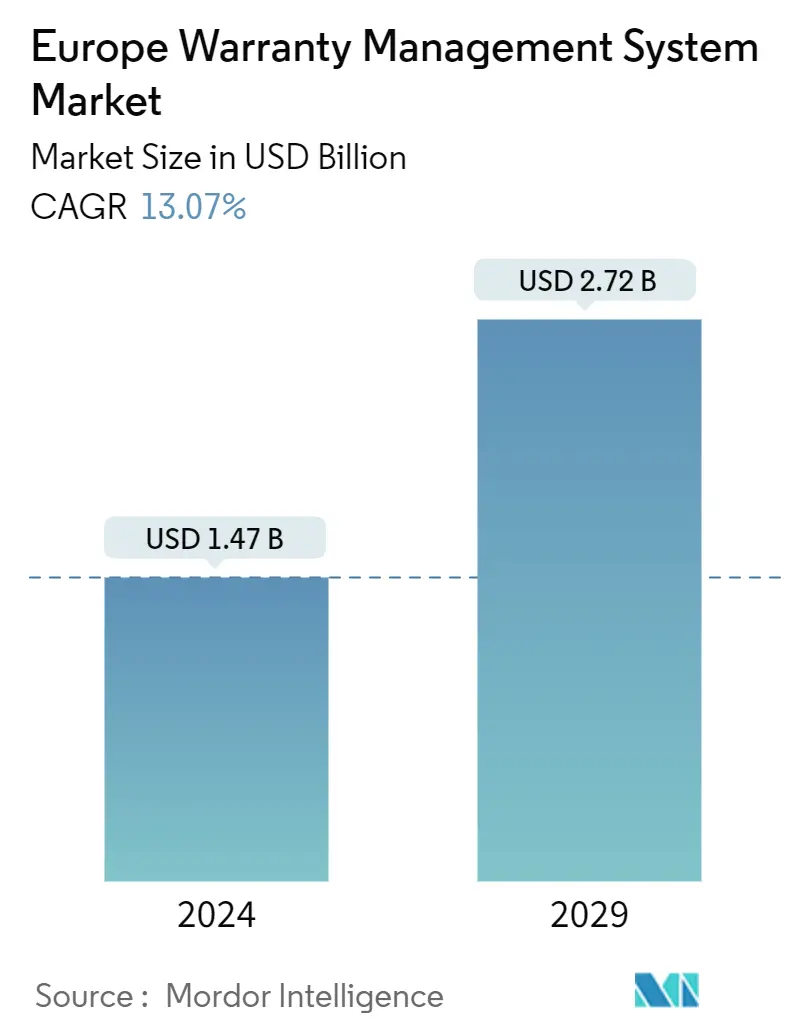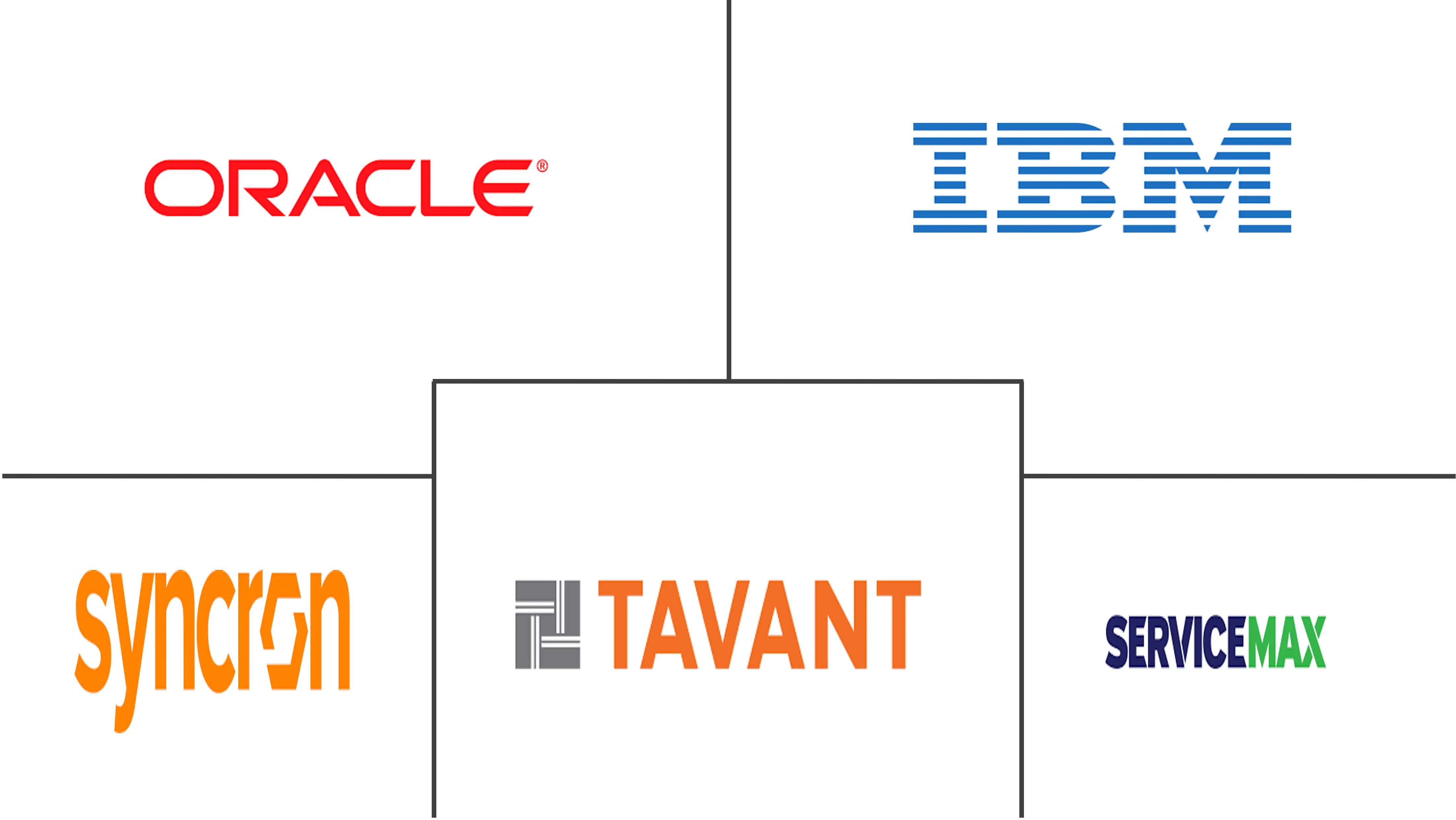Market Size of Europe Warranty Management System Industry

| Study Period | 2019 - 2029 |
| Base Year For Estimation | 2023 |
| Market Size (2024) | USD 1.47 Billion |
| Market Size (2029) | USD 2.72 Billion |
| CAGR (2024 - 2029) | 13.07 % |
| Market Concentration | Low |
Major Players
*Disclaimer: Major Players sorted in no particular order |
Europe Warranty Management System Market Analysis
The Europe Warranty Management System Market size is estimated at USD 1.47 billion in 2024, and is expected to reach USD 2.72 billion by 2029, growing at a CAGR of 13.07% during the forecast period (2024-2029).
- A crucial part of every service business is warranty management. The capacity to view, access, and automatically track client asset warranty coverage and data is critical. With warranty management, companies may be protected by loss of sales and customer displeasure.
- The warranty management system enables service businesses to design, administer, track, and process warranties, claims, and assets by automating warranty claim handling and installed base asset tracking. Innovative warranty management systems (WMS) are linked with AI and machine learning capabilities to guarantee customer satisfaction, driving the European market.
- The automobile sector's management of warranties is complex because the abundance of data, which spans the entire process from suppliers to dealers to final consumers, increases the probability of errors at different levels. Although each dealer and manufacturer has unique procedures for handling warranty claims and data, the traditional systems frequently do not produce reliable or consistent results, fuelling the adoption of warranty management systems in Europe, supported by the region's industrial development in automating.
- The warranty management system improves the accuracy and quality of warranty information by validating all privilege features using broad business rules and immediately incorporating information streams from diagnostic and mobile devices into warranty claim forms. The application handles the authorization of returns, tracking of returns, and creation of RGA/RMA or approvals for returns of material. By managing supplier warranties for parts and components, the warranty tracker enables suppliers and manufacturers to work together to cut warranty costs, fueling market adoption.
- However, due to the increasing competition and the increase in the Price sensitivity in the European warranty management system, providers are limiting the market growth because end users could compromise service features over price while choosing the warranty management system for their business due to the high price sensitivity in the market. Additionally, inaccurate diagnosis, excessive maintenance, fraud, and overcharging resulting from a lack of understanding of the warranty and repair procedure hamper the market growth rate during the forecast period.
- With the COVID-19 pandemic, the shift toward automated technologies has been significant across the region. Considerable advantages like enhanced productivity, data reliability, enhanced claim data validity, quality, etc., are luring customers into adopting automated warranty management systems with AI and ML, contributing to the market's growth rate.
Europe Warranty Management System Industry Segmentation
The Europe Warranty management system primarily caters to the software and services of warranty and post-warranty support management solutions. The solutions include warranty registration, claim submission, processing and settlement, fraud detection, supplier recovery, returns management, extended warranty marketing, replacement parts logistics, and inventory management.
Europe's Warranty Management System Market is Segmented by Deployment (On-premise and Cloud), End-user Industry (Industrial Equipment, Automotive and Transportation, and Consumer Durable), and Country. The report offers the market size in value terms in USD for all the abovementioned segments.
| By Deployment | |
| On-Premise | |
| Cloud |
| By End-user Industry | |
| Industrial Equipment | |
| Automotive and Transportation | |
| Consumer Durable | |
| Other End-user Industries (Medical Devices, Aerospace, Defense, Etc.) |
| By Country | |
| United Kingdom | |
| Germany | |
| France | |
| Rest of Europe |
Europe Warranty Management System Market Size Summary
The European warranty management system market is experiencing significant growth, driven by the increasing need for businesses to efficiently manage warranties, claims, and assets. This demand is particularly pronounced in sectors such as automotive, where the complexity of warranty management due to extensive data flow from suppliers to consumers necessitates the adoption of advanced systems. These systems, often integrated with AI and machine learning, enhance customer satisfaction by automating claim handling and improving data accuracy. The shift towards automated technologies, accelerated by the COVID-19 pandemic, has further propelled the market, as businesses seek to improve productivity and data reliability. However, the market faces challenges such as price sensitivity and the need to address issues like inaccurate diagnosis and fraud, which can hinder growth.
The adoption of cloud-based solutions is also contributing to the market's expansion, as companies increasingly move their data to the cloud to reduce capital expenditure and streamline warranty management processes. The availability of public and hybrid cloud services, along with the need for enhanced security, is facilitating this transition. Germany, in particular, is a key player in the region, with government regulations and industry demand driving the adoption of warranty management systems. The market is characterized by a high level of fragmentation, with major players like Oracle, IBM, and Syncron investing in customized solutions and forming strategic partnerships to maintain their competitive edge. These developments underscore the growing importance of warranty management systems in enhancing operational efficiency and customer satisfaction across various industries in Europe.
Europe Warranty Management System Market Size - Table of Contents
-
1. MARKET INSIGHTS
-
1.1 Market Overview
-
1.2 Industry Attractiveness - Porter's Five Forces Analysis
-
1.2.1 Bargaining Power of Suppliers
-
1.2.2 Bargaining Power of Buyers
-
1.2.3 Threat of New Entrants
-
1.2.4 Threat of Substitutes
-
1.2.5 Intensity of Competitive Rivalry
-
-
1.3 Assessment of the Impact of COVID-19 on the Market
-
-
2. MARKET SEGMENTATION
-
2.1 By Deployment
-
2.1.1 On-Premise
-
2.1.2 Cloud
-
-
2.2 By End-user Industry
-
2.2.1 Industrial Equipment
-
2.2.2 Automotive and Transportation
-
2.2.3 Consumer Durable
-
2.2.4 Other End-user Industries (Medical Devices, Aerospace, Defense, Etc.)
-
-
2.3 By Country
-
2.3.1 United Kingdom
-
2.3.2 Germany
-
2.3.3 France
-
2.3.4 Rest of Europe
-
-
Europe Warranty Management System Market Size FAQs
How big is the Europe Warranty Management System Market?
The Europe Warranty Management System Market size is expected to reach USD 1.47 billion in 2024 and grow at a CAGR of 13.07% to reach USD 2.72 billion by 2029.
What is the current Europe Warranty Management System Market size?
In 2024, the Europe Warranty Management System Market size is expected to reach USD 1.47 billion.

